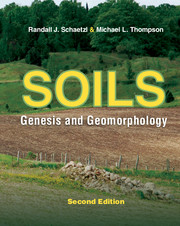3 - Basic Concepts: Soil Horizonation … the Alphabet of Soils
Published online by Cambridge University Press: 12 January 2024
Summary
Soil Horizons
Most of the Earth's surface contains soils, and most soils have discernible, genetic horizons, that is, genetic layering. Horizons are what distinguishes soil material from nonsoil sediment. Soil horizons may be absent in areas where erosion rates exceed the rates of soil development, as on steep slopes. In other places, horizons may not occur because they have not yet formed in young sediment, or because the sediments are essentially inert material devoid of nutrients that would support vegetation. Regardless, the presence of one or more genetic horizons indicates the existence of a soil, and vice versa.
Early soil scientists used terms like soil layer, vegetable mould, stratum, and level to describe these genetic layers (Tandarich et al. 2002). For almost a century (Shaw 1927), a layer formed by pedogenic processes that is more or less parallel to the soil surface has been called a soil horizon. Moreover, because its origin is pedogenic, referring to it as a genetic horizon is also appropriate. Anderson (1987, 56) described soil horizons as the “working aggregates of the whole (soil) system, and, like the organs of an organism, … generally adapted for the performance of specific functions.” In this chapter, we describe the basic characteristics of the major soil horizons. These types of horizons are different from and not to be confused with diagnostic horizons, which are defined for the purposes of soil classification and will be discussed in Chapter 8.
Types of Soil Horizons
Soil horizons generally form within unconsolidated materials on geomorphically stable surfaces that have been subaerially exposed for a sufficient length of time. In fact, pedologists often use the presence of well-developed horizons as an indication that the surface below which the soil is forming has been relatively stable for a considerable period (see Chapter 14). Horizons form as material is translocated (upward, downward, or laterally) within the profile or as it is transformed (chemically or physically) in place (Simonson 1959; see Chapter 12). Pedogenic processes tend to form distinct horizons within the upper mantle of unconsolidated materials, i.e., certain types of horizons are often associated with a certain suite of pedogenic processes (see Chapter 13).
Ever since Vasili Dokuchaev and Nikolai Sibirtsev introduced them at the 1893 World's Columbian Exposition in Chicago, soil horizons have been divided into a few types of master horizons.
- Type
- Chapter
- Information
- SoilsGenesis and Geomorphology, pp. 29 - 49Publisher: Cambridge University PressPrint publication year: 2015

